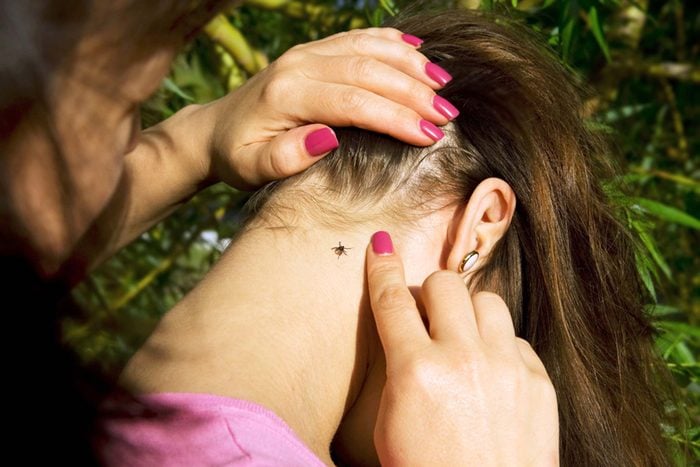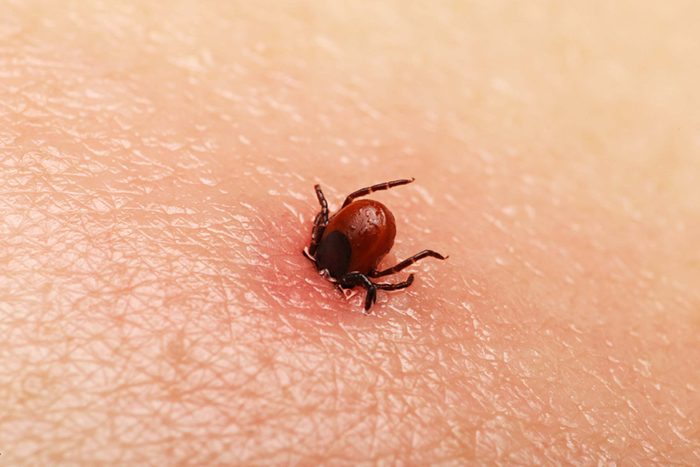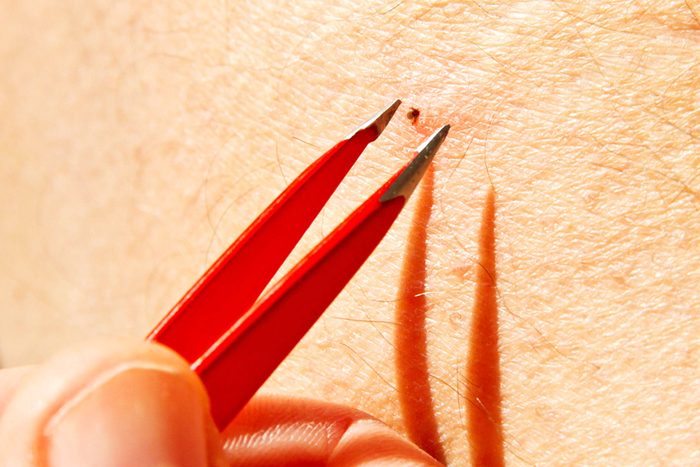Why you need to take precautions
Ticks can be infected with bacteria, viruses, or parasites. Some of the most common tick-borne diseases in the United States include Lyme disease, babesiosis, ehrlichiosis, and Rocky Mountain Spotted Fever, according to the federal Centers for Disease Control and Prevention. Lyme disease causes fever, headache, fatigue and a skin rash, and if left untreated, can spread to a person’s joints, heart, and nervous system. Of particular concern is Powassan disease, which is reportedly on the rise. Marked by fever, headache, vomiting, weakness, confusion, seizures, and memory loss, this tick-borne illness may cause long-term neurological damage, according to the CDC. That’s why it’s so important to learn how to prevent tick bites.

Stay the course
“Avoid heavily wooded areas and shrubbery as these are more likely to harbor ticks,” says infectious disease specialist Sunil Sood, chairman of pediatrics at Northwell Health’s Southside Hospital in Bay Shore, New York. In other words, don’t go bushwhacking or run off into the brushes.
“Ticks climb onto blades of grass and brush on the side of trails, so walk in the center of a trail and try not to brush up against grass and make sure to avoid leaf litter too,” adds Sunjya Schweig, MD, member of the board of adviser for the Bay Area Lyme Foundation and the CEO and co-director of the California Center for Functional Medicine in Berkeley, California. “Ticks also like to congregate under logs or trees, so don’t take a break by sitting under an oak tree or on a log.”

Ask around
If you are planning to hike or spend time in a park or recreational area, ask a forest ranger or another official about the current tick situation, says tick expert John Abbott, PhD, director of museum research and collections at the University of Alabama Museums in Tuscaloosa. (Here’s why you should never ignore a tick bite—or any of these bug bites.)

Use insect repellant
“DEET (chemical name, N,N-diethyl-meta-toluamide) is very safe if you are older than two months,” Dr. Sood says. “Choose and use products with 25 to 50 percent DEET which should provide up to six hours of prevention.” Products containing DEET include Off!, Cutter, and Ultrathon. “Children should not touch repellent,” he says. Adults should apply tick repellent to their hands and gently spread it over the child’s exposed skin.

Dress the part
“Wear closed, tight shoes and long pants. You want clothing between you and the environment,” Abbot says. Some clothing is already insecticide-treated including those sold at Insectshield. Another option is permethrin sprays, Sood adds. “Apply it to clothing including hats, shorts, socks, and sneakers as well as outdoor furniture such as patios and tents–but not skin,” he says. “Soak the items well and let it dry overnight and use DEET on exposed skin—these combined measures are probably the best tick prevention out there.”
Another tip: If you wear light-colored clothing, you will be better able to spot any ticks and brush them off before they make it to your skin, says Marc Alabanza, program director at GroundSea Fitness in Great Barrington, Massachusetts.

Head for the dryer when you get home
“Take off all of your clothing and socks and place them in the dryer on its highest setting for 20 minutes after coming in from a hike or time in a park,” Dr. Schweig says. This will kill any ticks including those that carry Lyme disease that may have attached themselves to your clothing or socks, he says. (Here’s what to do if you find a tick in your house.)

Leave Fido at home
Hard as it is to leave your dog at home when you head out for a hike or some time in the great outdoors, a dog can bring a tick home and then find its way onto your skin where it can cause disease, Dr. Schweig warns. “Keep your dog up to date with tick repellents and brush his or her coat with a fine-tooth comb after time outdoors and try and remove ticks that haven’t attached,” he says.

Check yourself
There is no specific way to check your skin for ticks or a tick bite. Just keep in mind a tick mistake people often make is not looking everywhere after spending time in wooded areas, Abbot says. “Tick legs are very well adapted for grabbing a hold of skin and clothing,” he says. “Check your head, behind your neck, your underarms, on your ears, and really anywhere on your body.” With ticks that carry Lyme disease, it takes 24 to 36 hours of an infected tick feeding on you to transfer it. “If you check yourself and successfully remove even an infected tick within that time, you’ll be OK.” Remember that ticks can be extremely small (poppy-seed sized) and may be mistaken as a freckle, adds Dr. Schweig, who suggests parents use a high-powered headlamp when checking kids for ticks.

Remove the tick
If you find a tick or sustain a tick bite, don’t panic—here’s what to do if you find one. “There are tons of ticks out there and most are not infected, so the risk of tick-borne illness is low,” Abbot says. Here’s how to remove a tick without spreading disease: “Imagine that the mouth is the straw going into your skin and the goal with the tweezers is to go in, clamp off the mouth part and pull the tick up,” Dr. Schweig says, warning that this may also pull up skin. “Wait for a minute so it releases and then remove the entire head and body.” Importantly, you don’t want the body to break, squeeze, or squirt as any extra bacteria inside the tick could then be transmitted to your skin.

Next steps
If you find a tick attached to you, a family member, or a pet, consider sending it to a lab for analysis, Dr. Schweig says. “Ticks are nature’s dirty needle and some of the bugs they carry are extremely smart and capable of invading the immune system so identifying the tick and what disease/s it may carry is a good way to reduce risk of tick-borne illness.” Preventive therapy with antibiotics can make a difference. “Bag it and send it to a lab because if you catch it early and are more aggressive,” Dr. Schweig says, “you have an excellent chance of completely preventing any long-term problem.” Ask your doctor or state public health department where and how to test the tick for disease. Next, check out these natural tick repellents you can make at home.
